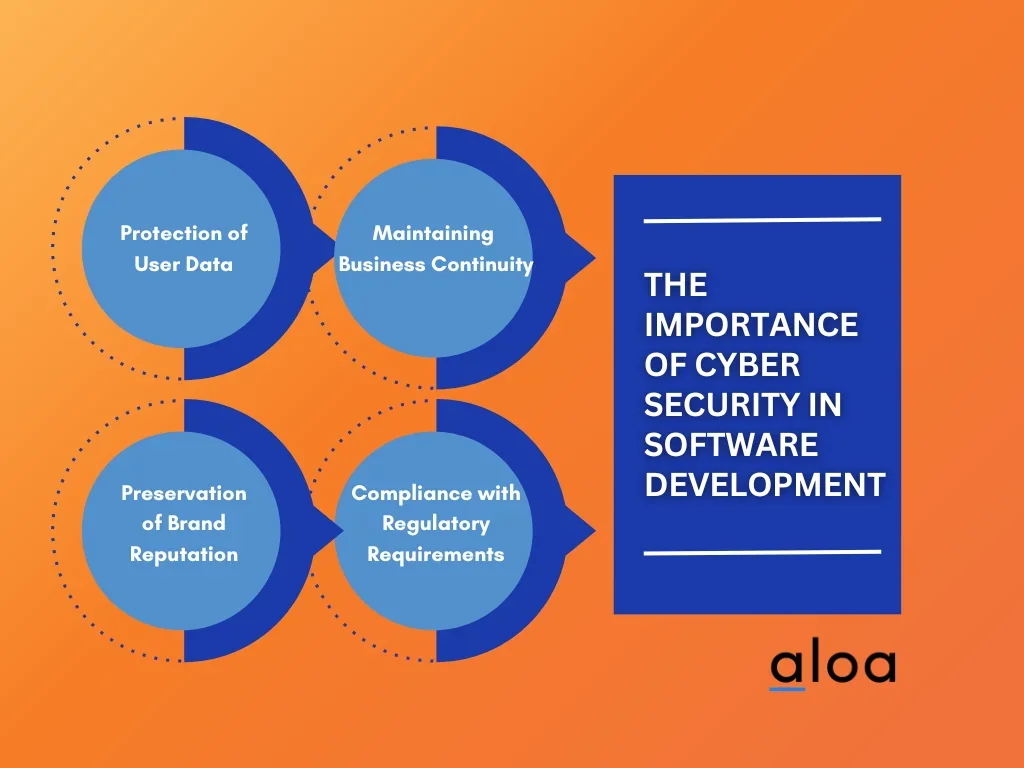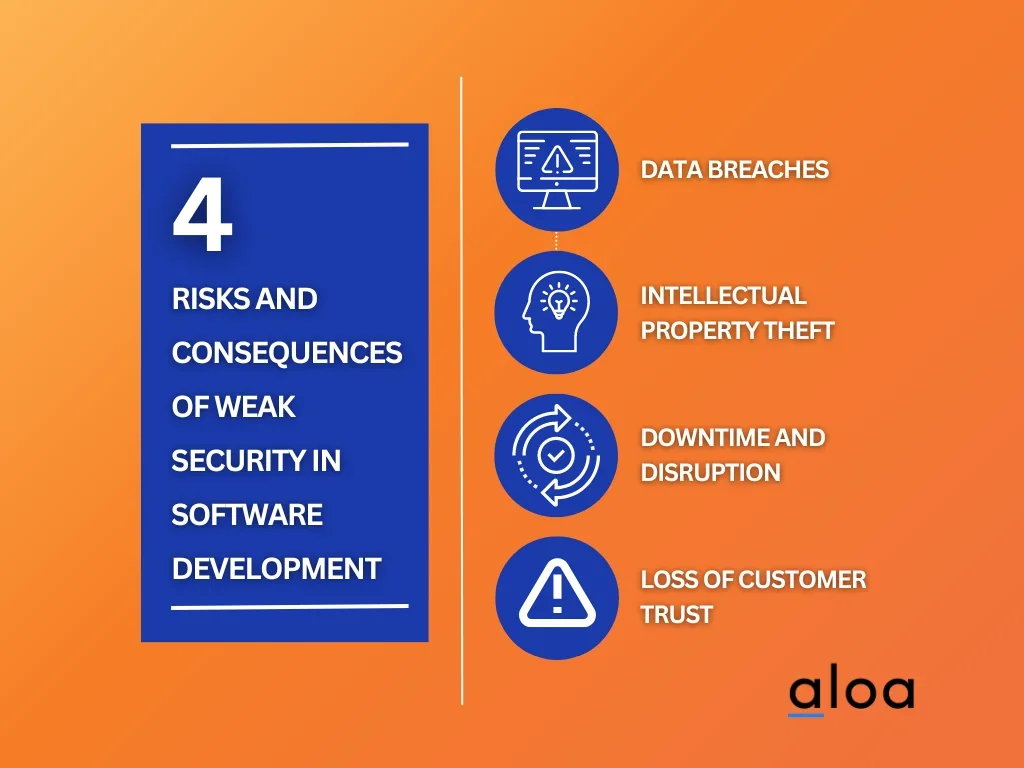So what is cyber security? In our increasingly digitized world, the looming threat of cyber attacks has made cyber security a topic of utmost importance. With every piece of information and every transaction happening online, the digital landscape is a place of immense opportunity and considerable vulnerability. As businesses undergo digital transformations, they must ensure the security of their digital assets to keep up with the pace of technology. One such critical area of focus is software development, where incorporating cyber security can no longer be an afterthought but a pivotal part of the process.
As experts in software outsourcing, we have seen firsthand how startups can sometimes overlook cybersecurity in their haste to build innovative products. Aloa strives to build software products rich in functionality and user experience and secure from any possible threats. While it's essential to innovate and overgrow in today's tech-driven market, ignoring cybersecurity could potentially danger the foundation upon which these startups are built.
This blog will delve into cyber security's intricacies, particularly its importance in software development. We will unpack why cybersecurity is critical in building secure software products and how overlooking it can have dire consequences for startups. The world of cyber security might seem daunting, but with the correct understanding and strategies, its integration into software development can significantly benefit your business. So, brace yourselves as we navigate the fascinating world of cyber security.
Let's dive in!
What Is Cyber Security?
Cyber security protects computer systems, networks, mobile devices, and data from digital attacks, unauthorized access, theft, or damage. It encompasses several fields. Each field focuses on securing different aspects of a system, creating a multi-layered defense against potential cyberattacks.
Implementing firewalls or antivirus software is not the only aspect of cyber security. It is a comprehensive approach that involves identifying potential vulnerabilities, implementing robust security measures, and constantly monitoring and improving these measures to combat evolving cyber threats. This involves everything from securing the physical infrastructure to encrypting sensitive data and ensuring that it is secure.
The scope of cyber security extends beyond the traditional realms of computer systems and the Internet. The advent of the Internet of Things (IoT) now covers a multitude of devices and systems, all of which need to be secured. This is where best practices such as risk assessment, robust authentication mechanisms, the use of a password manager, strong passwords, end-user education, and regular system updates come into play.
Different Types of Cyber Security Threats and Defenses
In the dynamic world of cyber security, the threats we face continuously evolve, as are the defenses deployed to counter them. Below, we delve into several prominent cyber threats and the defenses to safeguard against them.
Cyber Threats
.webp)
- Malware: This is a broad term that encompasses various types of malicious software, including viruses, ransomware, and spyware. Malware is typically used to damage or disrupt computer systems, steal sensitive data, or gain unauthorized network access.
- Phishing: Phishing is a deceptive practice where cybercriminals send fraudulent emails masquerading as a legitimate entity to trick individuals into revealing sensitive information, such as credit card details or login credentials. You can identify these emails by using an SPF checking tool and by carefully examining the email's content for inconsistencies, suspicious links, or grammatical errors.
- Ransomware: A specific type of malware, ransomware encrypts a victim's files, with the attacker then demanding a ransom to restore access. These attacks increasingly target critical infrastructure, such as hospitals and power grids.
- Social Engineering: This tactic involves manipulating individuals into performing actions or revealing confidential information. Phishing is a type of social engineering that involves person-to-person manipulation, such as pretexting or baiting.
- DDoS Attacks: In a Distributed Denial-of-Service (DDoS) attack, attackers overwhelm a system with traffic from many sources, rendering it inaccessible to legitimate users.
- Man-in-the-middle (MITM) Attacks occur when attackers position themselves between two parties in a digital conversation. The attacker can intercept, send, and receive data for someone else without either party knowing.
Cyber Defenses
.webp)
- Firewalls are network security systems that monitor and control incoming and outgoing traffic based on predetermined security rules. They establish a barrier between secured and controlled internal and external networks, like the Internet.
- Antivirus Software: This software is designed to detect, prevent, and remove malware threats on individual computing devices, networks, and IT systems.
- Encryption: Encryption converts information or data into a code to prevent unauthorized access. It's commonly used to protect sensitive data in transit, such as online credit card transactions.
- Intrusion Detection Systems (IDS): These systems monitor network traffic for suspicious activity and issue alerts when such activity is discovered. Some variants, called Intrusion Prevention Systems (IPS), can also take steps to block the threat.
- End-User Education: An often overlooked but critical aspect of cyber defense, end-user education involves training users about security best practices, like how to spot phishing attempts and the importance of using strong, unique passwords.
- Two-Factor Authentication (2FA): This security measure requires two forms of identification to access an account or system. One of the most widely used methods is the OTP (One-Time Password), which provides an extra layer of protection. Even if attackers obtain passwords, they need the second factor—often a physical device—to gain access.
These threats and defenses underline the complex nature of the cyber security landscape. Remaining vigilant, adhering to best practices, and employing robust security measures are all crucial in maintaining security in the face of these challenges.
Types of Cyber Security
Different types of Cyber Security focus on different aspects of the digital landscape:
.webp)
- Network Security: Protects the integrity and usability of the network and data by preventing unauthorized access, modifications, or destruction.
- Application Security: Focuses on keeping software and devices free from threats by identifying, fixing, and enhancing the security of apps.
- Information Security: Protects the integrity and privacy of data, both in storage and transit.
- Operational Security: Includes the processes and decisions for handling and protecting data assets.
- Disaster Recovery: A plan for responding to a cyber security incident or any other type that causes a loss of operations or data.
- Cloud Security: This involves securing data used in cloud services. Using Cloud-Native Application Protection Platforms (CNAPP) is key to ensuring strong data protection and security while combining and integrating multiple functionalities such as posture management, infrastructure management, and code scanning.
In conclusion, cyber security is indispensable in developing secure software products. It protects sensitive information, ensures the integrity of products, and builds trust with end-users. Startups and established companies must integrate robust cyber security measures into their software development process to counter the ever-evolving cyber threats.
Best Practices for Cyber Security in Software Development
Software and applications are integral to operations in every sector. Cyber security has become an absolute necessity. With increasing instances of data breaches and cybercrime, it is more important than ever to secure software systems and protect them against malicious actors such as hackers and cybercriminals.
.webp)
Secure by Design Approach
Adopting a 'secure by design' approach is the first step towards embedding cyber security into software development. This method involves integrating security risk management into every stage of software design and development instead of considering it as an afterthought. Following guidelines from organizations like the National Institute of Standards and Technology (NIST) in the United States can help ensure comprehensive security coverage. The NIST offers a cyber security framework as a roadmap to better protect your information technology infrastructure against potential threats.
Continuous Testing and Auditing
Ensuring real-time data security requires continuous testing and auditing of your software. For example you can use companies who offer threat intelligence as a service to make sure that you are always protected. By doing so, you can identify vulnerabilities before cyber criminals do. Techniques like endpoint security testing provide real-time protection against potential threats, keeping your software safe. When compliant with the National Institute of Standards certification standards, these testing and auditing procedures bolster your software's security infrastructure. Additionally, implementing an insider threat protection solution can help monitor and mitigate risks from internal sources, further strengthening your overall security posture.
Vulnerability Patching and Regular Updates
Continuous patching of vulnerabilities and regular updates is another critical aspect of cyber security. The rapid evolution of cyber threats, from Trojans to advanced cybercrime techniques, necessitates these regular updates. It's like a never-ending game of cat and mouse with cybercriminals; staying updated is your best defense. Leveraging vulnerability intelligence can further strengthen this approach by providing insights into the most pressing security flaws and guiding prioritization of patching efforts.
Staff Training and Awareness
While all these technical aspects are vital, we must recognize the human element in cyber security. Providing proper training for cybersecurity jobs and increasing staff awareness about potential threats forms the last pillar of a robust cybersecurity strategy. Ensuring your team understands the significance of issues such as physical security, content compliance solutions, and supply chain risks can be instrumental in preventing breaches. Additionally, employing network penetration services can further fortify your defenses by identifying vulnerabilities that could otherwise be exploited by malicious actors.
Incorporating these practices into your software development process enhances the security of your products. Methods like SLAM cybersecurity help proactively identify and mitigate threats, safeguarding your software and reinforcing your commitment to data security. It safeguards your software against potential attacks and enhances your reputation as a reliable software provider, affirming your commitment to data security. Remember, a proactive approach is always better than a reactive one in cyber security.
The Role of Cyber Security in the Software Development Life Cycle
Every software development life cycle (SDLC) stage is susceptible to cyber threats. This is why integrating cyber security from the inception of a project through to its maintenance phase is essential. It's not just about fixing vulnerabilities, it's about building inherently secure software.
The Importance of Cyber Security in Software Development

- Protection of User Data: Security breaches often lead to unauthorized access to user data. Software developers can significantly reduce this risk by implementing stringent cyber security measures and protecting their users' privacy and personal information.
- Maintaining Business Continuity: A security breach can disrupt business operations significantly, leading to downtime and loss of revenue. Effective cyber security measures ensure that software applications run smoothly and continuously.
- Preservation of Brand Reputation: Breaches impact a company's technical infrastructure and tarnish its reputation. Secure software development practices help maintain the trust of customers and stakeholders.
- Compliance with Regulatory Requirements: Many industries require compliance with specific cyber security standards. Adhering to these standards during software development can prevent legal issues and fines.
Security Considerations in Different SDLC Stages
Design Stage
This is the conceptual stage of the SDLC, where security should be a prime consideration. Developers should consider potential threats and build a design that minimizes vulnerability. For example, they should ensure secure user authentication and data encryption.
Development Stage
During this stage, developers write the code for the software. Secure coding practices can help prevent common security issues like SQL injection and cross-site scripting (XSS). Also, using version control systems can track changes, detect anomalies, and recover from alterations due to potential security breaches.
Testing Stage
Security testing is critical to detect vulnerabilities in the software. This includes penetration testing, vulnerability scanning, and security auditing. The goal is to identify and fix potential security issues before deploying the software.
Deployment Stage
The deployment stage involves transitioning from a development environment to a live environment. Proper access controls should be in place to prevent unauthorized changes to the software. Security measures such as intrusion detection systems (IDS) can also help promptly identify and respond to security breaches.
Maintenance Stage
The software's security must be continuously updated to address new threats and vulnerabilities. Regular security patch updates, system upgrades, and continuous monitoring are essential during this stage.
Cyber security is a crucial component throughout the software development life cycle. It's about protecting the software and its users and maintaining business operations, upholding brand reputation, and meeting regulatory requirements. Remember, building secure software is easier than fixing security issues later. The importance of considering cyber security at every stage of the SDLC cannot be overstated.
Overlooking Cyber Security: A Common Mistake in Startups
Reasons why startups tend to overlook cybersecurity
Regarding cyber security, startups often need to pay more attention to this critical aspect of their business. Let's explore some of the common reasons behind this oversight:
- Budget constraints: Startups typically operate on limited budgets, primarily focusing on product development and marketing. As a result, they may view cyber security as an unnecessary expense, prioritizing other areas instead. However, failing to invest in robust security measures can be costlier in the long run, considering the potential damages caused by cyber-attacks.
- Lack of awareness: Many startup founders and team members may need a comprehensive understanding of cyber security and its importance. They may need to fully grasp the risks associated with weak security practices, assuming that their small size or relatively unknown status will make them less likely targets. Unfortunately, this misconception leaves them vulnerable to cyber threats. That's why for example, there is a big need for cybersecurity for law firms as law firms are dealing with a lot of sensitive date.
- Time constraints: Startups operate in a fast-paced environment, often racing against competitors to bring their products to market quickly. This time pressure can lead to corners being cut, with cyber security measures being sacrificed in favor of faster development cycles. However, overlooking security measures can expose vulnerabilities that hackers can exploit.
Risks and Consequences of Weak Security in Software Development
The consequences of overlooking cyber security in software development can be severe, potentially jeopardizing a startup's success and reputation. Here are some risks and consequences associated with weak security practices:

Data breaches
Weak security measures can result in unauthorized access to sensitive user data, such as personal information, login credentials, or financial details. A data breach can lead to severe legal consequences, financial losses, and irreparable damage to a startup's reputation.
Intellectual property theft
Startups often possess valuable intellectual property, including unique algorithms, innovative technologies, or proprietary processes. Inadequate security measures can leave these assets vulnerable to theft, compromising a startup's competitive advantage and prospects.
Downtime and disruption
Cyber attacks, such as Distributed Denial of Service (DDoS), can disrupt a startup's operations, causing website or service downtime. This can result in revenue loss, dissatisfied customers, and damage to business relationships.
Loss of customer trust
In the age of data privacy concerns, customers are increasingly cautious about sharing their information with companies. A security breach can erode customer trust, leading to a loss of clientele and hindering future growth opportunities.
Startups must recognize the importance of cyber security in software development. By prioritizing security measures and integrating them into their development processes, startups can mitigate risks, safeguard their assets, and instill customer confidence.
Key Takeaway
Overlooking cyber security can be a costly mistake, particularly for startups. The risks and consequences of weak security practices in software development are significant and can lead to data breaches, intellectual property theft, downtime, and loss of customer trust.
What is cyber security is a question that every business should ask themselves. Startups should consider implementing secure coding practices, conducting regular security assessments, and implementing encryption and authentication protocols. Additionally, seeking the assistance of cyber security experts can provide invaluable guidance and support in building secure software products.
If you require further assistance or guidance in implementing robust cyber security measures for your startup, contact [email protected]. Our experts at Aloa are dedicated to assisting startups in building secure and innovative software products. Remember, prioritizing cyber security is a necessary precaution and a strategic advantage that can propel your startup toward long-term success in the ever-changing digital landscape.

